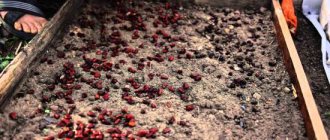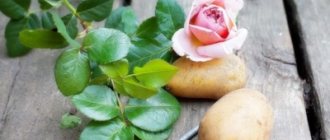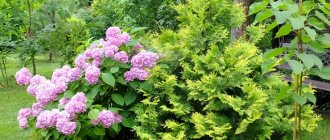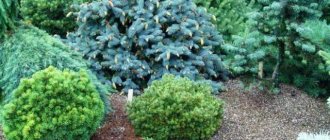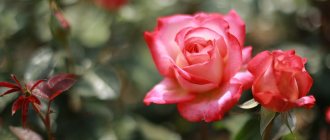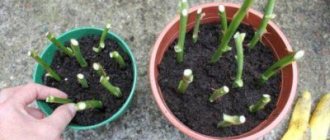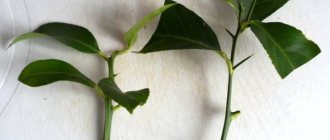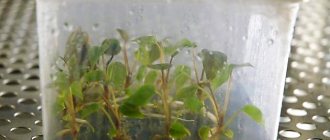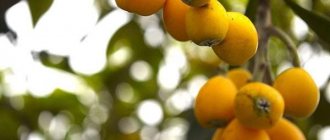Propagation of conifers by cuttings - what are the features?
Reproduction and rooting of coniferous plants by cuttings depends on the species and genus of the plant. For example, varieties such as thujas, junipers, yews, and cypresses get along well. Fir, as well as Konika spruce, take root much worse. If we talk about pine and larch trees, strengthening them with the help of cuttings is incredibly difficult; rarely can anyone achieve even minimal results. It is important to choose the cuttings themselves wisely. It is best to take green young shoots, making sure that the cutting belongs to an even, dense, healthy plant.
If you choose a bad shrub, your new “seedling” will be exactly the same. It is also not advisable to take side shoots, since the future plant may begin to bend during growth, which means it will not have a beautiful, even shape. And even pruning conifers will not lead to a positive result. It should be remembered that there are several rules for planting cuttings that you should also be aware of. By following them, you will do your job perfectly.
Description
This evergreen coniferous tree from the Pine family grows in temperate climates. Fir, by description and appearance, is often confused with spruce. It has a narrow, hard crown, smooth or with deep cracks (depending on the variety), as well as long branches that often reach the ground, take root in it, and take root, thus allowing the crop to reproduce. Fir roots are quite large and powerful, which allows them to reach great depths in the ground and hold an overgrown tree during strong gusts of wind.
Each branch bears comb or spiral needles; they are flat and velvety to the touch. This is the first and main difference between fir and spruce, which has prickly and long needles. Also, unlike spruce, fir exudes a more delicate and soft coniferous aroma, not so concentrated and tart. Its cones are directed vertically, whereas those of spruce they hang from the branches and grow straight down.
This coniferous tree is better suited for landscaping an area than all other species of the Pine family, as it has a dense crown structure, regular shapes and can be used as decorative plantings that additionally protect other plantings from strong winds. More and more Europeans and Russians are choosing fir as a New Year's decoration, since even when the branches are completely dry, the small needles do not fall off and the tree looks sophisticated in comparison with its more bulky relatives.
Types of fir
There are 50 species of fir growing in the temperate zone of our planet. The following are the most popular among breeders:
- Siberian.
- Single color.
- Sakhalinskaya.
- Nordmann or Caucasian.
- Subalpine.
- European.
- Korean.
- Sciadopitis (Japanese umbrella).
- Balsamic.
All of them grow in cool regions of Russia, Canada, North America, and are also widely used in the field of landscape design. Many varieties of fir harmoniously coexist with deciduous trees, pines, spruces, thujas and feel great even in arid climates, sometimes reaching 300-400 years of age.
How to take cuttings of coniferous plants at home?
If you want to achieve the effect, take cuttings of juniper, thuja or cypress. From the main branch or from smooth side shoots we tear off a cutting with a “heel” (a piece of wood with bark). If there are pine needles, they must be cut off with a sharply sharpened knife, and the “heel” itself should not be too long. After you have prepared 5-7 cuttings, collect them into a bouquet, carefully tie them up so as not to fall apart, and soak them in a solution such as Epin for 12 hours.
To achieve maximum effect, you need to take a few drops per 100 ml of water. When the cuttings have spent the required time in the solution, it is necessary to dust them in a root formation stimulator. Kornevin is considered the most practical and reliable. After this, we fill the container for planting with sand, watered with a solution of potassium permanganate, which will help rid it of possible bacteria and pests. We make holes in the sand using wooden pegs - they need to be installed at an angle of 45-50 degrees.
Plant care
Growing the crop is not difficult; it does not require special care procedures. An unpretentious evergreen plant does not need frequent watering; rainfall is sufficient. If the summer is hot and there is little rain, the soil in the tree trunk is irrigated once a month, spending 10–15 liters on a young tree and 30–50 liters of water on an adult tree.
This type of conifer also rarely requires fertilizer: for the first 3 years, the mixture placed in the planting hole is sufficient. Then, every spring, a mineral complex is added - for example, “Kemira-universal”, 100 g/m².
To retain moisture in the soil and protect the roots from overheating, as well as from the dominance of weeds, the tree trunk circle is covered with mulch. The material used is fallen pine needles, sawdust or tree bark. Before mulching, the soil must be well fluffed up, allowing the root system to breathe.
For the first 8–10 years, fir is a slow-growing crop, so careful pruning is not carried out during these years. But the ornamental plant needs a sanitary pruning and a small shaping procedure. In the spring, remove weak and broken shoots that grow inside the crown or get out of shape.
Important! It is undesirable to cut off more than a third of the length of the branches at one time, otherwise the tree will stop growing. Fir is resistant to diseases and pests with proper care
To protect it from troubles, preventative treatments against infections and pests are carried out in the garden every spring. At the beginning or end of March, depending on the region, the crop is sprayed with a Rogor solution prepared in a proportion of 20 g per 10 liters of water. After 3 weeks, planting is treated with 2% Bordeaux mixture
Fir is resistant to diseases and pests with proper care. To protect it from troubles, preventative treatments against infections and pests are carried out in the garden every spring. At the beginning or end of March, depending on the region, the crop is sprayed with a Rogor solution prepared in a proportion of 20 g per 10 liters of water. After 3 weeks, planting is treated with 2% Bordeaux mixture.
Growing conifers from cuttings in the ground
When preparing beds for planting, you need to remember that the ground level should be 15 cm lower from the edges of the formwork. This is necessary to maintain normal humidity and temperature for the development and growth of cuttings. We also carefully break off a small shoot from the “parent”, which forms the “heel”. Using a sharp knife, cut off the tip of the wood. During this work, a wound is created that stimulates root formation of cuttings in the future. That is why it needs to be moistened with a growth regulator (1% solution of indolylbutyric acid).
At the bottom, remove all the leaves using a knife. But it is undesirable to touch the growth point at the very top. Next we prepare a place for planting seedlings. To do this, take a wooden peg and stick it into the ground to a depth of 3 cm. We strongly compact the ground near the stem. The following cuttings should be planted at a distance of about five centimeters. We water the bed itself with a fungicide solution and cover it with film. Our plant should develop in this way for about one year, and in winter, in order to avoid freezing, it must be covered with mats or wooden shields.
How to grow fir from a twig
The process of propagation of fir branches includes several stages. First, cuttings are selected and prepared, then storage conditions are provided for them. For rooting you will need a substrate, containers and a certain microclimate. When the cuttings take root, they are transferred to an open area.
Selection and preparation of cuttings
It is best to use cuttings from young trees between 4 and 8 years old. Look at the branches from the top of the crown. If you cut cuttings from the lower or middle areas, the likelihood of them rooting will be significantly reduced. In such seedlings, the trunk has a curved shape, and the crown branches incorrectly.
Healthy annual shoots are selected from the parent tree. The optimal length of cuttings is from 10 to 25 cm. There should be an apical bud on the branch. If you damage it, the trunk will begin to branch, and the crown will take on an irregular shape.
To cut cuttings, use pruning shears or a knife. The cut should be located 1 cm down from the site of lignification. This area is clearly visible due to the color transition from green to brown.
Important! It is allowed to use branches with two-year-old wood at the base - the so-called “heel”. Then they are not cut off, but torn from the trunk with a sharp movement.
At a distance of 4 - 6 cm, the needles and small branches are completely removed. Under favorable conditions, new roots also appear from these places.
How to root a fir from a branch
After receiving the planting material, they begin to root it. The branches don't hold water. If the shoots are collected at the end of summer or autumn, they are sprayed with water and wrapped in a damp cloth.
Cuttings ready for planting are placed in a solution of a root growth stimulator. Without such treatment, fir practically does not take root. They use special preparations Kornevin, Ukorenit, Ribav. They are dissolved in water according to the instructions.
Good results are obtained by rooting fir cuttings in a solution of IBA - indolylbutyric acid. It is obtained in a concentration of 0.01%. At elevated levels, the acid has a toxic effect. The solution works best at a temperature of +20 °C. The working fluid is unstable to light and heat.
Advice! It is not recommended to keep fir cuttings for more than 24 hours. An alternative option is to apply the drug dry to the lower part of the shoot.
Additionally, the lower edge of the cuttings is dipped into a solution of potassium permanganate or the drug Fundazol. This will disinfect the material and avoid fungal diseases.
For cuttings of fir in winter, prepare a substrate consisting of turf soil, humus and sand. All components are taken in equal proportions. If soil from the site is used, it is first heated in an oven to disinfect it.
To root cuttings, use plastic containers, in which drainage holes must be made to remove moisture. The optimal height of containers is from 10 to 15 cm.
The procedure for cutting fir at home in winter:
- Earth mixed with humus is poured into containers in layers, with sand on top.
- The cuttings are deepened by 2 - 6 cm at an angle of 45°. Leave 10 cm between them.
- Plantings are covered with film.
- The substrate is watered abundantly.
The material is rooted at a temperature of 20 - 25 ° C and a humidity of 90%. Additionally, diffused light is required. If the day is too short, turn on the phytolamps.
The process of root formation takes up to 9 months. First, callus is formed in the lower part of the shoot in the form of new formations on cracks and cuts. Then the roots grow. The appearance of callus does not guarantee that the seedling will take root.
Video about propagating fir by cuttings at home:
Pros and cons of fir cuttings
Among the methods of propagation of coniferous trees there are several vegetative and seed ones. Among the first:
At home, gardeners prefer to propagate fir using cuttings.
- And there are several advantages over other methods:
- obtaining a plant with maternal characteristics;
- the procedure is not labor-intensive, time is spent mostly on rooting;
- high percentage of seedling survival;
- no dependence on the season.
You can harvest cuttings at any time of the year, the main thing is to choose the right planting date . Spring, summer and autumn seedlings are rooted this year. Shoots harvested in late autumn or winter are stored in a cool room until spring.
Experts consider final rooting to be the only drawback only in the second year after planting . Before viable roots appear, the cutting will grow callus - tissue capable of creating new parts of the plant, i.e. root shoots.
Fir propagation
Firs are propagated mainly by seeds
: cuttings take root with great difficulty. Decorative forms are well propagated by grafting even on other species.
Collecting fir seeds is much more difficult than those of spruce or pine. The fact is that the cones of adult fir trees are concentrated high on thin tops, and after ripening they quickly crumble.
Sowing
Sowing depth is 1–2 cm. The best time is autumn. Seeds for spring sowing should be stored in the refrigerator or in the basement at high humidity. When sowing in spring, seedlings appear in 25–35 days. In open places, the sprouts are shaded.
At first, the fir grows slowly: at four years it reaches a height of only 30–40 cm. All this time, the plant develops mainly the root system.
Diseases and pests of fir
Only trees that are weakened by unfavorable weather get sick. The most common ailments are browning of needles and rust shoot cancer. The affected crown is treated with copper oxychloride and cuts and wounds on the trunk and branches must be disinfected.
The most dangerous pests are silkworms and various types of aphids.
How to properly prepare a cutting
The procedure is carried out on a cloudy day, in the morning. A tree no older than 8 years is selected as a donor . Cuttings are harvested from annual branches that have at least one apical bud. It is recommended to pay attention to the northern side of the plant crown.
Length of the workpiece - up to 10 cm; You definitely need to cut off the branch with a piece of bark . Having made an incision, it is better to sharply tear it off. Before starting rooting, you need to clean up the protruding pieces of wood and make sure that there are no peelings of bark from the wood layer at the very heel of the branch.
Pests and diseases
According to reviews from experienced breeders, fir is quite resistant to diseases and dangerous insects, but sometimes it is affected by hermes fir. This aphid causes yellowing of branches and death of needles. To get rid of such a scourge, use a solution of the drug Antio or Rogor. The entire tree, including the trunk, is sprayed with these insecticides.
Often, the beautiful fir suffers from fungal rust, which causes rusty spots on the shoots and their yellowing. To save the plant, its crown is treated with a 2% boron solution, the affected branches are cut and burned, and the cut areas are soaked with garden pitch.
If a white coating appears on a young fir shoot, this is a sign of the appearance of winged aphids. Sometimes it is enough to prune the branches affected by the pest, but if the pathogens have spread deeper, the crown will need to be treated with insecticidal solutions.
When a spider mite appears, the fir needles begin to change color and quickly fall off. A tincture of dandelion flowers helps kill it. Vegetable infusions (tomato and onion) are used to treat a tree if caterpillars that secrete mucus begin to multiply on it. To boost natural immunity, it is advisable to water and spray young fir seedlings, as well as adult trees, with bio-preparations, for example, Ecosil or Novosil, once a year. They are made from organic compounds, as well as fir needles and resin.
Rooting process
To prevent fungal diseases, the cuttings are treated with a fungicide, for example, “Fundazol” (10 g per 0.5 l of water) or a weakly concentrated solution of potassium permanganate. You need to soak it in the disinfectant mixture for 4–6 hours.
To prepare the substrate, take equal parts of the following components:
The container or box is placed in a lighted and warm place without drafts. Lighting should be diffused so that direct sunlight does not hit the plant. The shoot is buried in moist soil at an angle of 45°, 5–7 cm.
It is recommended to root fir with bottom heating so that the soil in the container warms up to +20...+22°C. The air temperature is maintained in the range of +16…+19°С.
At first, the cutting is under the film. The seedling is ventilated daily and condensation is removed. For the winter, the container with fir is put away in the cellar or on a heated veranda . In the spring it must be taken out into the fresh air again.
Twice during the winter the seedling is fed by adding 10 g of the Green Needle preparation, after which it is thoroughly watered.
Sowing seeds
Seeds are sown at the end of March. The soil should be sandy loam and loose; a layer of sawdust (2 cm thick) should be poured onto it. The seeds are laid out on the first layer of sawdust, and sprinkled on top with another layer 1-1.5 cm thick (fresh pine sawdust is used for it) and watered abundantly. The greenhouse is covered with film and protected from direct sunlight. Approximately 1-2 times a day, the greenhouse is opened slightly for ventilation and watering. Although, instead of watering, it is better to spray with water from a spray bottle. When growing seedlings, the soil is kept moderately moist. Excessive waterlogging can cause seed rotting. After emergence of seedlings, the covering material must be removed. The seedlings are fed three times during the summer using complex mineral fertilizers for conifers. Fertilizing is combined with watering.
Transplantation into open ground
Young plants should be planted in an area with light shade, with groundwater not higher than 2.5 m from the surface. The rooted seedling can be transferred to a permanent place of growth in April or September . When planting several specimens, you need to leave a distance of 5 m between them.
Video: How to properly plant and care for fir
Transplant technology:
- A socket measuring 70x55 cm is prepared 2 weeks before the procedure.
- A layer of drainage material 20 cm thick is required at the bottom.
- Before planting, the soil extracted from the pit is mixed with 250 g of wood ash and 50 g of superphosphate.
- Having placed the plant on a mound at the bottom of the hole, the depth of which corresponds to the length of the roots, it is sprinkled with soil on all sides.
- In this case, the growth point of the tree remains above the surface.
- After watering, the soil should get wet 20 cm deep.
Preparing for landing
Before starting all the procedures, you should know that breeding fir by seed does not guarantee that the exact variety from which the seeds are collected will grow. The genetic memory of such planting material contains only species qualities, i.e. you will definitely grow a fir, but what variety will become known only when the seedling reaches a more mature age (7–10 years). The first thing to do is get the seeds. They can be purchased in specialized stores or assembled yourself.
If everything is very clear with the purchase, then the collection must be treated with special care, the main thing is to do it on time. Fir cones open when ripe, and the seeds are carried by the wind over a very long distance. This is a plus for natural propagation, but not for the gardener who needs planting material. You should go to the forest at the end of October - beginning of November; you don’t have to climb a tree, you can look under it.
Important! Only two-year-old cones are suitable for harvesting planting material. They have gray wings, while annual ones have green wings. If there are only a few fir trees, then the probability of finding seed material is significantly reduced and, most likely, you will have to climb the tree for cones
After collecting the seed, it is cleaned of scales (it does not need to be thrown away, it will become an addition to the mulch layer), dried, put in a linen bag and sent for separation (stratification) in the refrigerator. Such storage is necessary to improve seed germination
If there are only a few firs, then the probability of finding seed material is significantly reduced and, most likely, you will have to climb the tree for cones. After collecting the seed, it is cleaned of scales (it does not need to be thrown away, it will become an addition to the mulch layer), dried, put in a linen bag and sent for separation (stratification) in the refrigerator. Such storage is necessary to improve seed germination.
Landing dates
The timing of planting depends on how you will grow the fir - the seed is planted in open ground in the fall after it is collected, the container method involves spring (mid-season) planting. The specific time for planting in pots is determined individually and depends on the location of the seedlings. The microclimate is important for her - it should be warm, humid and light.
Preparation of planting material
For winter sowing, seeds do not need to be germinated. They are placed in the ground, as mentioned above, immediately after collection. They only need to be separated from everything unnecessary, the empty and rotten ones should be discarded, and planted in a prepared place. When planting in open ground in spring, the seed material, a month before the procedure, is removed from the refrigerator, soaked for half an hour in a solution of sodium permanganate, washed, placed in a linen bag with a damp substrate and sent to the refrigerator or buried in the snow.
Important! To open the buds, they are exposed to elevated temperatures. They are kept at +45°C for 24 hours, at +35…+40°C for two days. When planting them in pots at home, either:
When potted at home, they are either:
- keep in the refrigerator all winter;
- placed in perlite or sand (the substrate must be moist);
- soaked in water a week before planting.
Such manipulations will speed up the germination of seedlings. If you don’t do this and just plant dry seeds, sprouts will appear 2-3 weeks later.
Selection and preparation of a site
When planting in autumn, the planting site must be prepared in advance. Firstly, it should be an area protected from direct sunlight (partial shade), and secondly, it should not be exposed to drafts. Also, melt water should not stagnate on it. As for the soil, it needs to be rid of weeds, dug up and soil added for coniferous plants. Sand is added to the clay soil so that it is sandy, loose and well-permeable to oxygen and water. It is also worth preparing sawdust from coniferous trees.
The best place for growing seedlings will be on the windowsill, on the side where the sun shines only part of the day. It can also be a warm veranda or winter garden. The containers are filled with purchased soil mixture for coniferous plants or a self-prepared substrate from sand, sawdust and compost, taken in equal proportions. A drainage layer of coarse river sand, small fragments of broken brick, etc. is placed at the bottom.
Division and pre-processing
To prepare high-quality planting material, you need to know some tricks. With the onset of spring, the cuttings can be planted in the garden.
It is worth taking side branches for divisions. They should have a small piece of wood left. It is often called the “heel”.
Too large and long parts of the bark must be trimmed. Then it will be possible to avoid the onset of rotting. It is advisable to remove the needles from the bottom of the cutting.
Prepared cuttings need proper processing. The procedure will protect plants from diseases and conifers will develop better.
First, you should place the cuttings in a special solution. It is made from water and Epin. You need to add 2 drops of the product to half a glass of water.
The delenki should be soaked in it for about 12 hours. Thuja and juniper can take root well without stimulants. However, the cuttings in question from evergreen plants require special attention. Additional help will not harm the winter divisions.
While the cuttings are in the stimulator, you need to soak the dried sphagnum moss. The more water it soaks in, the better. When 12 hours have passed, remove the sections. Then roll up the disposable film. Its absorbent side should be on the outside.
Squeeze the sphagnum a little from excess moisture and spread it on the film. It should be located along it. Sphagnum is a powerful rooting substrate.
Dip the base of each cutting into the powder to form roots. You can take Kornevin. If necessary, it will be replaced by Ukorenit. Place the cuttings again on the film. Fold it in half and press the stems of the cuttings to the sphagnum.
Transplanting a purchased seedling
If a fir seedling was purchased in the winter months, then there is no need to rush to replant it. It is necessary to hold it a little in the same conditions in which it grew earlier. If the store or nursery was cool, then the seedling should be placed on the balcony for several days. Then move it in its original container to the place where it is planned to be kept permanently. And only then should the transplantation begin.
Many people are interested in how long fir grows. In a pot it will grow by about five centimeters every year. So sooner or later it will have to be transplanted into open ground. And there she can live for more than a hundred years.
Fir does not like drafts; it is better to choose a cool, dark place for it, but it will also grow in a brightly lit window. Before replanting the plant, it must be watered well so that the substrate becomes moist and well saturated with water.
Propagation of conifers by cuttings in winter is the easiest way to obtain seedlings
Adding an article to a new collection
Thuja, juniper, cypress and other coniferous crops have already become an invariable feature of summer cottages. But the price of seedlings is steep - you can still buy a couple of plants, but what if you need more than a dozen?
Fortunately, conifers take cuttings quite well, and the best time for this, oddly enough, is winter. If you or someone you know already has thorny bushes or trees on your property that you would like to propagate, the coming winter gives you a chance.
Types and varieties of fir with photos and names
There are quite a large number of species and varieties of fir, but not all of them are popular with gardeners. Below we will describe those that are more or less in demand in culture.
Balsam fir (Abies balsamea)
Under natural conditions, such fir can be found in the United States and Canada, while its habitat in the north is limited to the tundra. In mountainous areas, such a tree can be seen growing at an altitude of 1.5–2 thousand meters. This frost-resistant, shade-loving plant does not live very long, only about two hundred years. The height of such a plant can vary from 15 to 25 meters, and its trunk reaches 0.5–0.7 meters in thickness. Young firs are covered with gray-ashy smooth bark. Old trees have cracked brownish-reddish bark. Resinous pale green buds have a light purple hue and are spherical or ovoid in shape. The dark green glossy needles can reach 1.5–3 centimeters in length; stomatal lines run along their entire surface. The needles may be slightly notched at the top or blunt; they die off after 4–7 years. If you grind them, you can smell a pleasant aroma. The height of the oval-cylindrical cones can vary from 5 to 10 centimeters, and their width is 2–2.5 centimeters. Unripe cones are dark purple in color, which changes to brown after ripening. Mature buds are highly resinous. This species has been cultivated since 1697. This fir is planted singly or used in small group plantings. The most popular forms are:
- Hudsonia . This mountain dwarf plant has very dense branches, a wide crown and many short stems. The short needles are wide and flat in shape, their front surface is green-black, and their back surface is bluish-green. Cultivated since 1810
- Nana . The height of the tree does not exceed half a meter, the diameter of the rounded crown is about 250 centimeters. Dense spreading branches are located horizontally. The short, lush needles are dark green, with 2 bluish-white stripes on its lower greenish-yellow surface. Cultivated since 1850. This plant is perfect for landscaping roofs, terraces, and rocky gardens.
The following forms of this type are also cultivated: gray fir, variegated, dwarf, silver, columnar, and also prostrate.
Korean fir (Abies koreana)
In nature, this species can be found in the mountains of the southern part of the Korean Peninsula at an altitude of 1.8 thousand meters. These fir trees create pure and mixed forests. Young firs grow very slowly. However, in older specimens, the growth rate becomes faster over the years. Such a tree can reach a height of 15 meters, with a trunk diameter varying from 0.5 to 0.8 meters. The crown shape is cone-shaped. Young specimens are covered with smooth, ash-colored bark, in some cases with a purple tint. Old specimens have chestnut bark with deep cracks. Almost round buds are only slightly resinous. Lush needles are quite tough. Each needle is saber-shaped and has a notch at its top. The upper surface of the needles is dark green in color, and the lower surface is silver (due to 2 very wide stomatal stripes). The length of the cylindrical cones is about 5–7 centimeters, and they can reach 3 centimeters in diameter. Young cones are colored lilac-purple. This plant was brought to European countries only in 1905. This species is distinguished by its very high decorative value due to its two-color needles, as well as its winter hardiness. This article describes the planting and care of this particular type of fir. Varieties:
- Blue Standard . It differs from the original species only in the dark purple color of the cones.
- Brevifolia . This cultivar is characterized by extremely slow growth and a dense, rounded crown. The needles are not as dense as the original type, its upper surface is painted swamp green, and the lower surface is grayish-white. The color of the small cones is purple.
- Piccolo . The tree can reach only 0.3 m in height. In an adult specimen, the diameter of the spreading horizontal crown can reach up to 50 centimeters. The needles are the same as those of the main species.
Caucasian fir, or Nordmann fir (Abies nordmanniana)
This species is considered a Caucasian endemic, because in nature it can only be found in the Caucasus Mountains. This plant can reach a height of 60 meters, and the trunk is about 200 centimeters thick. The low branched lush crown has a narrow conical shape. The top of the crown is sharp, but in sufficiently mature specimens this is not too pronounced. The trees are covered with glossy, smooth bark, but after the plant turns 80 years old, deep cracks form on it. The ovoid buds have virtually no resin. The length of the needles is about 4 centimeters, and its width is approximately 0.25 centimeters, its upper surface is painted dark green, and on the bottom there are 2 stripes of white color. On cone-bearing shoots, the tips of the needles are softly pointed, and on vegetative shoots there is a notch at the tips. The cones reach 20 centimeters in length and 5 centimeters in diameter. Young cones are green, while old ones are resinous dark brown. This species is fast-growing, and such a plant can live for about 500 years. Forms of Caucasian fir: weeping, golden-tipped, gray, erect, golden and white-tipped.
Single color fir (Abies concolor)
Such a fir is considered the queen among representatives of the fir genus. Under natural conditions, it can be found in the Southwestern United States and Northern Mexico. This tree prefers to grow in river canyons, as well as on mountain slopes at an altitude of 2 to 3 thousand meters above sea level. This species is very resistant to drought, and such a tree can live for about 350 years. Its height can vary from 40 to 60 meters, and the thickness of the trunk reaches 200 centimeters. The cone-shaped crown of a young tree is very lush, but as it ages, it thins out significantly. The color of the bark on older specimens is ash-gray, and it is very rough and cracked. The green-yellow resinous buds are spherical in shape and about 50 mm in diameter. The length of the green-gray needles can reach up to 7 centimeters, and its width - up to 0.3 centimeters. The apex of the needles is rounded and notched, with stomatal lines located on both their upper and lower surfaces. The shape of the cones is cylindrical-oval, they can reach 14 centimeters in length and 5 centimeters in width. The color of immature cones is green or purple, while mature ones are pale brown. Cultivated since 1831. This plant looks incredibly beautiful against the background of yellowed larches in the autumn. Popular decorative forms:
- Compact fir . A dwarf shrub cultivar with spreading branches and blue needles. In some cases it is called Compacta Glauca.
- Violacea . The height of such a fast-growing plant can reach up to 8 meters. The wide crown has a cone-shaped shape, and the long needles are painted bluish-white. This fir is distinguished by its very high decorative value and resistance to drought.
Siberian fir (Abies sibirica)
Under natural conditions, it can be found in the northeast of Russia, while this tree prefers to grow in river valleys, as well as in the highlands. This species is distinguished by its winter hardiness and shade tolerance, and it is under state protection. Siberian fir is the most famous species of all that are included in this genus. The plant can reach no more than 30 meters in height, and its narrow crown has a cone-shaped shape. The gray bark is smooth along almost its entire length, but at the very bottom it cracks. The narrow glossy needles are very soft, and they reach 30 mm in length. Their upper surface is dark green, and on the lower there are 2 stripes of white color. Ripe erect cones become pale brown. Varieties of Siberian fir: white, graceful, blue, variegated, etc.
Not only the species described above are cultivated, but also such firs as: subalpine, Fraser, whole-leaved, equal-scaled, Semenova, Sakhalin, myra, graceful, cephalin or Greek, tall, Vicha, white-barked or bud-scaled, white or European and Arizona.
Video: how to properly plant and care for fir
Seedlings no younger than 4 years old are planted in open ground. To make the plant easier to tolerate planting, it is recommended to carry out the procedure in the fall. A rainy/cloudy day is ideal. A suitable place for growing fir is shade/partial shade, with well-drained soil.
Planting stages
- In about 10-14 days, a hole for the seedling is prepared. The approximate dimensions of the recess are 60x60x60 cm. More precisely, the dimensions depend on the size of the fir root system. A drainage layer up to 6 cm thick is laid on the bottom (crushed stone and broken brick will do). Half of the hole is filled with soil mixture. Recommended composition: humus, clay, peat, sand (in the ratio 3:2:1:1). Sawdust (10 kg) and nitrophoska (about 30 g) are also added.
- A seedling is planted, and its root collar should be located at the level of the surface of the site.
- The roots of the tree are straightened and the entire hole is filled with the prepared soil mixture.
- The tree is watered.
If you plan to plant more than one seedling (at least an alley), then it is better to immediately adhere to the correct planting scheme. The standard distance between seedlings is 4-5 m. But these requirements may vary, depending on the type of fir. Trees with dense branches can be spaced about 2.5 m apart. And more spreading firs are planted in increments of 3-3.5 m.
Care after planting fir cuttings
To grow a tree from a fir branch, it is important to properly care for young plants. In the first years after planting, their development is slow.
Plantings are watered regularly, but do not allow moisture to stagnate in the soil. Periodically loosen the soil to a depth of 25 cm and weed out weeds. For feeding, choose Kemira fertilizer or other mineral complexes.
To mulch the soil, peat or sawdust is used, which is poured into the tree trunk circle. For the winter, the young tree is covered with spruce branches or non-woven fabric.
